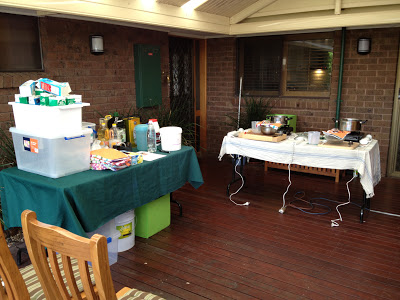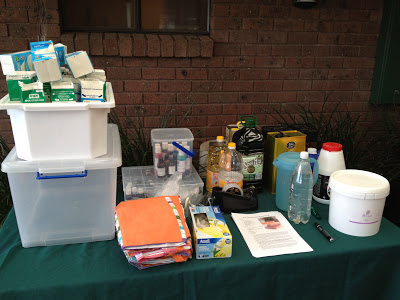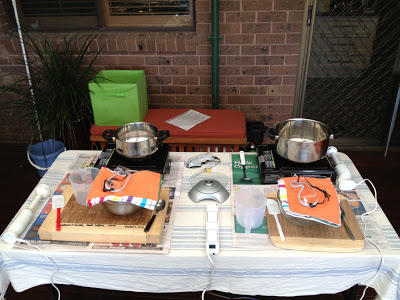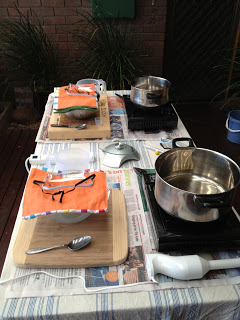However, as we like to hone our presentation technique before embarking on such an endeavor, we wanted to make sure that we had the basics down pat. We wanted to try the setup, safety precaution instructions, and gather feedback from people whose opinions we trust and respect. We had a proven recipe that made a nice all-round bar of soap, so we stuck to what we knew worked best.
So we opened the workshop up to members of our community group for a small fee that would allow us to break even. We had to purchase safety equipment, aprons, second hand equipment (due to buy nothing new month), oils, fragrance and type up instructions. We also had to source a cheap soap mould, which we managed by using 1 litre waxed cardboard milk cartons. I found the milk cartons easy to use, however Kim did not like them and prefers the wooden moulds we normally use. Looks like I will have to make some wooden ones.
As you can see, the setup had everything. I used the camp stoves that I purchased for cheesemaking workshops, and the vast majority of the equipment you see on the table (except safety equipment) was sourced from op shops.
We found that the small class of three that we taught in the morning was a good size, and everyone kept interested during the workshop. However the larger class of five in the afternoon was a bit drawn out, even though we stuck to our timings perfectly. It took each student 25 minutes to make a batch of soap, taking it nice and slow. If someone looked like they were rushing things, I instructed them to slow down and relax. To see our technique in action, and why homemade soap is better than commercially made stuff, have a look at our Soap Making YouTube video.
We learnt a few things ourselves from the experience. Our safety precautions worked well, but I found the you still have to watch participants like a hawk. If someone looks like they may injure themselves, don’t hesitate to step in. I few times I had to remind students to be more cautious when mixing with the stick blender, or mixing the water and caustic soda. No one was offended when I stepped in, because I gave a warning during the safety instructions that I would take action if necessary.
The class size really can only be a maximum of four. It is the easiest to teach safely, and the interaction between instructor and student is better. I personally found it slightly distracting with a larger class and with a few other observers talking in the background.
We also learnt that two stations are enough, but students found it awkward sharing the digital scales, and a single candy thermometer. Kim also mentioned that we should keep a lookout for two more sets of equipment when we are scouring the op shops. That way there would be limited washing up in between students, and the class would flow much better. We will fix that up before we schedule the next class.
Other than those few minor things, it was a perfect day. We all had fun, learnt new skills, and everyone walked away with some homemade, colourful, fragrant, vegetable based soap. I believe all the participants were pleased with the result.
We expect that there will be more classes coming soon to our local community house. If anyone has expressions of interest in the western region of Melbourne you are most welcome to contact me via email. Happy to share our skills for a low fee.
Kim and I were certainly pleased with the results of our planning and instruction. So after all the students had gone home, and when everything was cleaned and packed away, we indulged in a nice cold bottle of white wine and talked about how we could improve it further.
It was a great way to debrief and unwind after a fruitful and rewarding day.






wow it looks like it went fab. Soap is something I would like to try and make but I am a little scared of the safety side. I am a klutz. I would like to attend a soap making course here in the UK. That would be great. Then I can see clearly what is happening. Good for you showing others. They must have been so pleased.
you blogged before about climate change and cities etc. I saw this and thought I would pass the link on.
http://creatingsustainablecities.com/
Well done Gavin and Kim. It’s good to know there are others out there who want to learn these skills. People are always impressed when I give them some of my homemade soap but think that it would be too hard for them to make for themselves.
I started making soap this year. So far it has been a batch each of: plain soap, citrus poppy seed, lavender, and finally , oatmeal, honey and beeswax. I have had lots of compliments on my soap. I just used equipment from my kitchen, as I didn’t have much to invest in equipment. I also have been using 1 litre milk cartons, but have asked for a mold for Christmas. I love practical hobbies.
Keep up the good work, Gavin and Kim!
Barb